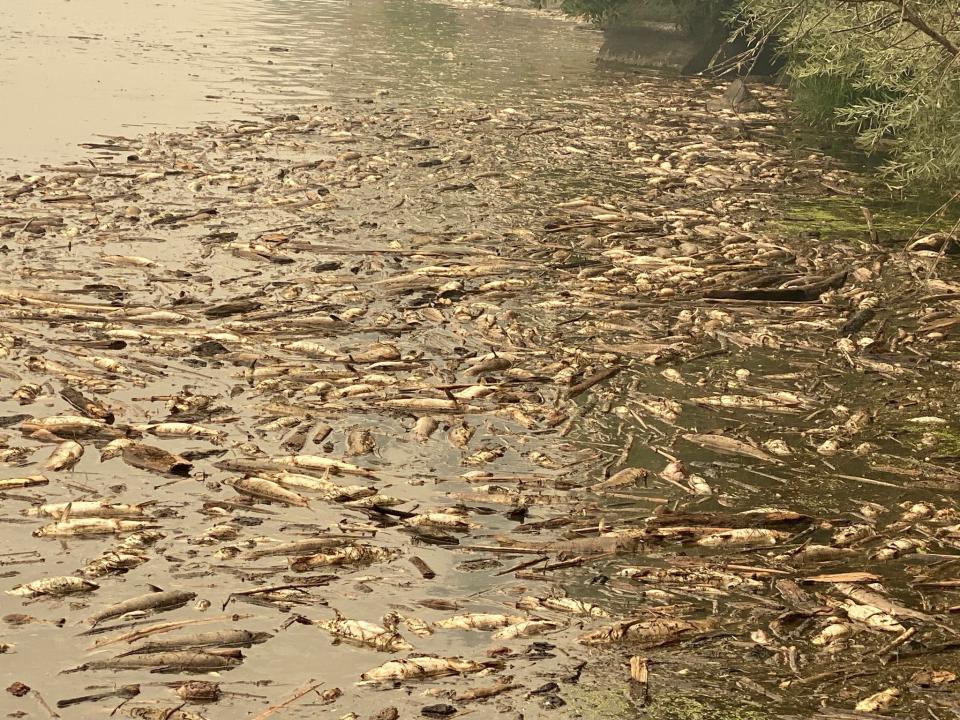Big fish kill on Klamath River spurred by debris slide from McKinney Fire
A large fish kill of multiple species, spurred by a massive debris flow into the Klamath River, has resulted from the McKinney Fire that is still burning in the region, according to the Karuk Tribe.
Photos released on Saturday by the tribe document the fish kill between Indian Creek, which flows though Happy Camp, and Seiad Creek about 20 miles further upstream. The photos show very large numbers of dead fish of multiple species, but predominantly suckers.
“Tens of thousands of fish, including suckers, juvenile salmon, lamprey eel, crayfish and resident trout/steelhead have perished in this fish kill,” said Craig Tucker, consultant for the tribe.
The Klamath River is the second largest salmon producer in California — and ocean recreational and commercial fishing seasons in California are crafted around the numbers of fall-run Chinook salmon that return to the river each year.
For the Yurok and Karuk tribes that live on the Klamath River and the Hoopa Valley Tribe that lives on the Trinity River, the salmon are central to their culture, traditions and ceremonies.
A massive debris slide out of areas impacted by the McKinney Fire entered the mainstream Klamath River at or near Humbug Creek and McKinney Creeks on Aug. 2 and 3.
“This led to dissolved oxygen levels dropping to zero for four hours on the nights of Aug. 3 and 4, according to Karuk Seiad Creek water quality station,” Tucker said. “The result was a fish kill. We know the impact is limited to 50 miles in the reach between Humbug Creek and Indian Creek. The fish we are seeing in Happy Camp and below are floating downstream from the ‘kill zone.’ ”

“The slides were so big that they doubled the flow of the river from 1,000 to 2,000 cubic feet per second and half of the flow was mud,” Tucker said.
“Water quality on the Klamath is horrible,” Tucker said. “There are mudslides not only on the mainstem of the Klamath, but on the Trinity and Salmon rivers. But we think the river is slowly recovering.”
He said the tribe doesn’t know yet if this fish kill will affect the fall adult Chinook salmon migration.
“The fall-run adults are now just coming into the river from the ocean. As sad as this is, we’re lucky that it didn’t happen three weeks from now. That could’ve been devastating to the fall run,” he said.
This spring the Klamath avoided the big juvenile salmon kills that took place on the Klamath last year. Tucker said the river saw really good spring escapement for juvenile salmon this year, since the river was blessed with rain in May.
More: Tribe: Flash flood during McKinney Fire kills thousands of Klamath River fish
He said the Klamath Fish Health Assessment Team, an interagency and intertribal technical workgroup that formed during the summer of 2003, is currently monitoring the situation and evaluating whether a flow dilution release would help.
The Karuk Tribe has been working with the Yurok Tribe, along with state and federal agencies, to gain access to the fire zone to better document and evaluate river conditions. New information will be shared as Karuk Fisheries continues the investigation.
On the Yurok Reservation, Yurok Tribal Fisheries biologists and technicians are currently monitoring the lower 44 miles of river for the presence of deceased fish.
Wildfire peril: Klamath National Forest's unique biodiverse landscapes under threat from wildfire
Meanwhile, the removal of the four PacifiCorp dams that block migration on the Klamath River is set to begin in 2023. “We’re optimistic that we will get the dam removal approval from the Federal Energy Regulatory Commission (FERC) this year,” Tucker said.
San Joaquin/Sacramento River stripers: Summer fishing for stripers remains as “good as it gets” on the west bank of the Sacramento River, the San Joaquin River near the Antioch Bridge and in Broad Slough, said Clyde Wands, a striper fishing expert.
On his latest trip, Wands, Dave Houston and Chester Linton of Roseville caught 18 keepers to 8 pounds, keeping 6 fish total, while trolling with Yo-Zuri lures both shallow and deep. “We quit fishing at 1 p.m.,” he said.
North Delta largemouths
Alan Fong of Fisherman’s Warehouse and Denise Loo caught and released over 30 largemouth bass while punching in the grass with Brush Hogs and D-Bombs (crawdad imitations) in the Liberty Island area on Monday. “Our biggest fish weighed 5½ pounds and we ended up with a limit totaling over 19 pounds,” he said. Information: (916) 362-1200.
Golden Gate salmon
Salmon trolling continues to be solid outside of the Golden Gate, although anglers are not catching full limits every day. On Aug. 8, the Lovely Martha finished up with 20 salmon to 27 lbs. for 12 anglers. On Aug. 7, the boat returned with 22 salmon to 20 pounds for 16 anglers. Information: (650) 619-6629.
Contact Stockton Record Correspondent Dan Bacher at danielbacher53@gmail.com.
This article originally appeared on The Record: McKinney Fire: Big fish kill on Klamath River spurred by debris slide

